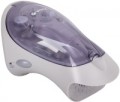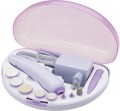Number of nozzles/tools
The total number of attachments or tools included in the kit.
Nozzles are referred to when it comes to an electric model, tools are indicated for instrument sets (see "Type"). In both cases, the more
diverse the equipment, the more extensive the possibilities of the manicure set, the more advanced it is considered. On the other hand, this indicator significantly affects the dimensions, weight and cost, and the real need for a variety of nozzles / tools does not always arise. Therefore, when choosing, you should take into account the features of using the device: it hardly makes sense to purchase a professional set of a couple of dozen tools if you just need to keep your nails in order while traveling.
Note that in sets that include double-sided devices (for example, with a scraper on one side and a cuticle spatula on the other), each side of such a device is considered a separate tool (as it has its own application).
Power source
The type of power used by the electric model (see "Type").
—
Network. Powered by normal household sockets. This option is convenient because you do not have to monitor the condition of the battery / accumulator: the machine will work as long as there is voltage in the network, and the risk of being left without power at the most inopportune moment (for example, in the middle of the work process) is minimal. On the other hand, in the absence of sockets, such models become practically useless; in addition, the mains cable restricts mobility.
—
Battery. Powered by an original branded battery that does not belong to standard sizes (see "Batteries" below), and in some models it is also non-removable. Like replaceable cells, batteries allow the machine to work regardless of the presence of outlets nearby; at the same time, in some moments this option is much more convenient. So, batteries are able to accumulate more energy, which has a positive effect on power and battery life; they are immediately supplied in the kit, which eliminates the additional hassle and cost of the purchase; and charging the battery is usually easier and cheaper than looking for fresh batteries. On the other hand, if there is a supply of batteries, they can be easily changed, while recharging takes time and a power source.
—
Batteries. Powered by replaceable elements of a stand
...ard size — for example, "finger" AA (other options may also be found). Such models, like battery ones, do not depend on sockets and can be used autonomously. The replaceable cells themselves can be produced both in the form of disposable batteries and in the form of rechargeable batteries. At the same time, both the first and second options make it easy to change dead batteries for fresh ones (the main thing is to stock up on them in advance). Of the shortcomings, it is worth noting the relatively low capacity, as well as the need for additional costs — either for the regular purchase of fresh batteries, or for rather expensive batteries. In addition, there are many batteries on the market, varying in price and performance, and the actual operating time is highly dependent on the quality of the batteries/accumulators used.
— Network / battery. Models that can work both from the network and from their own battery. The features of both types of power are described above, and their combination allows you to combine the advantages of both options and makes the machine very versatile: if you have an outlet, you can use it, and if there is no network nearby, run on battery power. The main disadvantage of such models is a slightly higher price than devices with one type of power supply.Power
The power of the device is related to both its performance and consumption. But in general, high power characterizes more features and improved typing performance.
So, models with a power of 3-15 W are intended for the most part for individual use. Manicure sets of this class are not designed to work in salons where there is a large flow of users. Low power devices are only suitable for processing natural nails.
Milling cutters with a power of 15-25 W can be classified as semi-professional. Manicure sets of this class can be safely used both at home and in a beauty salon, and the power of the product is quite enough for comfortable processing of both natural and false nails.
Milling cutters with a power of 25-50 W and more belong to the professional class. Such devices are designed for the most automated hardware manicure and pedicure. Milling cutters of this class allow you to quickly and safely serve a large flow of users. In addition, high-power manicure sets often additionally boast advanced functionality.
Number of speeds
The number of speeds at which the electric model can operate (see "Type"). For different nozzles, different speeds are considered optimal, and even for the same one, several speed modes can be used, depending on the desired processing intensity. Thus, the more speeds — the wider the capabilities of the device, the more accurately you can choose the best option depending on the situation. For maximum accuracy, however, it is better to select a model with smooth adjustment (see below), however, if this moment is not critical, fixed settings will still be more convenient.
Maximum revolutions
The maximum speed of rotation of the working nozzle of the set. The higher the rotation speed, the more performant the effect will be. But more is not always better, especially for sensitive people with delicate skin.
Usually, models with a maximum speed of up to 5,000 rpm are more suitable for processing natural nail tissue and cornea. Cutters with a maximum speed of over 5,000 rpm are already capable of processing both natural nails and false nails made of acrylic and other synthetic materials.
Professional grade manicure sets can have a maximum rotation speed of up to 30,000 — 45,000 rpm and even more.
Reverse
The presence in the electrical model (see "Type") of the ability to change the direction of rotation to the
opposite.
Most of the procedures carried out by electric machines imply a certain direction of movement of the nozzle relative to the nail being processed. And since the position of the nails themselves can also be different (for example, when processing different hands), the direction of rotation has to be changed. This possibility is provided due to the reverse — without it, the machine itself would have to be moved, and this, usually, is inconvenient (and in some situations it is impossible at all).
Backlight
The presence of a
lighting system in the design of an electrical device (see "Type"). Such a system provides additional illumination at the treatment site, which allows successful procedures to be carried out regardless of the presence of sufficiently bright external lighting. Just keep in mind that the backlight also requires electricity; this is not a problem when using mains power, however, when using a battery/accumulator, it can significantly reduce battery life.
Dryer for nails
The presence in the manicure set of the function of
drying nails.
Drying is usually found in electric models (see "Type"). It is most often implemented through a built-in fan that provides airflow to the nails; the fan can be placed inside the stand or be made as a separate nozzle. Another drying option is a UV lamp. However, anyway, this function is intended to speed up the drying of the varnish applied to the nails. However it must be borne in mind that for some varnishes, a fan is considered optimal, and for others, a UV lamp. Therefore, when choosing, it is worth specifying which option is implemented in the manicure set and whether it is suitable for the varnishes used.
Nozzles
Types of nozzles supplied with the manicure set. Nozzles are supplied with electric models only (see "Type").
—
Polishing cone. Conical nozzle designed for polishing — i.e. processing the surface of the nails in order to give them shine and a neat look. Has a small notch or felt coating. The shape of the nozzle allows you to process both individual small areas and large areas — in the first case, a pointed tip is used, in the second — the straight part of the nozzle is closer to the base.
—
Cone for grinding. In this case, it means a conical nozzle designed to treat dry and rough skin around the nails on the hands, as well as cleaning ingrown nails. It is usually small in size, which is why it may also be called a "thin cone nozzle".
— Cone for filing. Conical filing heads have a non-standard shape — they do not taper towards the end, like most cones, but, on the contrary, expand. This allows you to conveniently file your nails, including in hard-to-reach places. One of the most popular materials for such nozzles is corundum.
—
Oval for grinding. A small oval-shaped nozzle used for grinding the lateral ridges and the area along the cuticle.
—
Cylindrical for grinding. This attachment is designed to gently remove rough skin around the nails.
— Spherical for grinding. The s
...pherical working part of this nozzle has a small shape, so it is convenient for delicate treatment of nails and cuticle removal on hands and feet.
— Polishing disc. A disc nozzle with a fine notch or felt coating, designed for fine polishing of nails — both the nail plate itself and the edges after filing. It has a fairly large size, due to which it captures a larger area during operation than a cone.
— Grinding disc. The main purpose of all grinding discs is the treatment of rough skin and calluses — primarily on the legs, but there are nozzles for the hands. Note that discs can vary in size (larger for legs, smaller for hands) and processing intensity (for coarse and soft grinding).
— Cutting disc. A disc with a rough coating — usually corundum — designed for filing nails and giving them the desired shape. Especially such a nozzle is useful for large and thick nails. Discs can be designed for both fingers and toes; the second variety is noticeably larger.
— To lift the cuticles. A nozzle in the form of a characteristic spatula that allows you to lift the cuticle for accurate cutting (usually this is done after softening in the bath or using a special tool). One of the few nozzles that does not rotate during operation.
— To remove calluses. A specialized nozzle for removing corns, usually on the legs. It can have a different shape and design: in specialized machines for working with corns, this is usually an abrasive roller, in multi-purpose models — a cone.
— Cleaning brush. A device for gently cleaning the surface of the nail from dirt. Thanks to soft bristles, it does not have an abrasive effect and does not injure the nail and the skin around it.
— Massager. Nozzles of this type, usually, are intended for facial massage, however, some of them may have other specializations.
Note that this is not the whole list — in some models, other attachments may be provided, for example, a foam rubber sponge or an eyelash curler.
